2.1
The institutional structure for administration and supervision of REDD+ and other forest-based climate mitigation programs at national and sub-national levels are appropriate and support the participation of all sectors and all stakeholders.
2.2
The administration at all levels is transparent and effective.
2.3
The administration at all levels is fair and promotes participation
Transparent and effective national forest governance structures
REDD+ and other forest-based climate mitigation mechanisms or programs must uphold the principles of good governance; comprising of transparency, accountability, efficiency, and gender inclusion throughout the planning, implementation, and benefit sharing of results. The organizational structure and management of the mechanisms, programs or project at all levels must promote effective participation of all sectors and genders, encourage fairness and transparency in the operations and further strengthen forest governance of the country.
Principle
The structure for administration and supervision of REDD+ and other forest-based climate mitigation programs in Thailand is transparent and efficient, and enhances good governance in the forest sector.
- Constitution of the Kingdom of Thailand B.E. 2560 (2017), as the supreme law of the State, has several provisions concerning protection of individual rights and liberties (Chapter 3), especially Section 41 on the rights to be informed and access to public data or information possessed by state agencies, and present a petition and take legal action against a state agency. While also define duties of the state to disclose any public data or information which is not related to security (Section 59), maintain financial and fiscal discipline (Section 62), provide efficient measures and mechanisms to prevent and eliminate corruption (Section 63).

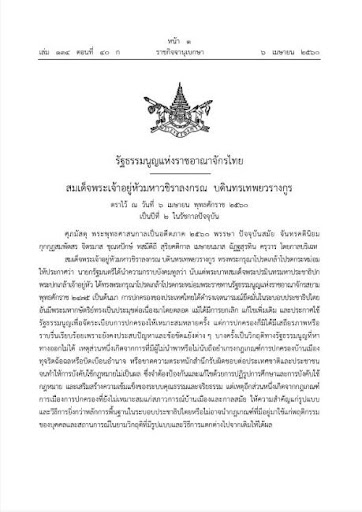
- The 20 years National Strategy B.E. 2561-2580 (2018-2037) has two relevant strategies include:
1) National Strategy on Public Sector Rebalancing and Development which aims to reform the public sector in terms of appropriate size and clearly defined roles, as well as open for intersectoral-operations and participation from all relevant parties and operate on a result-based basis, with good governance and commit to the general public interest at large, and employ big data and digital technologies to help improve the public sector’s performance in accordance with international standards.
2) National Strategy on Eco-friendly Development and Growth, has one of the goals on ensuring the country’s paradigm shift for the determination of the country’s natural resource and environment, as well as culture, based on good governance and public participation. The strategic guidelines include development of tools, mechanisms, justice process related to natural resource and environment in order to prevent environmental impacts, reduce on-going and emerging conflicts related to natural resource management. Develop environmental democracy by increasing roles of the public in conservation and management of natural resource and environment, access to environmental information, and creative participation on projects/programs that will affect the environment, social, health, and economy.
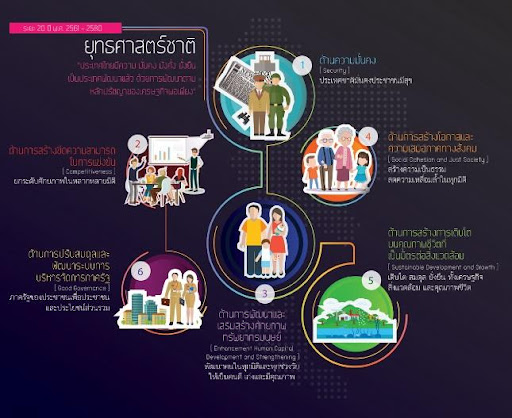
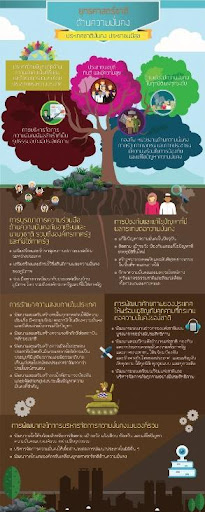

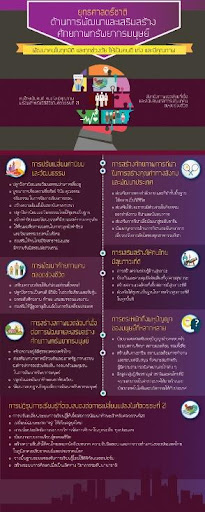


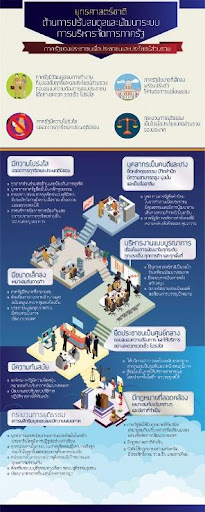
- The plans following National Strategy comprised of 23 national master plans, and 13 national reform plans. The master plans related to strengthening public sector governance include National Master Plan on Public Service and Public Efficiency, Master Plan on Anti-Corruption and Misconduct, and Master Plan on Law and Justice Process. While related national reform plans include reform plans on politic, public administration, law, justice process, and prevention and elimination of corruption and misconduct. The monitoring and evaluation of the national master plans and national reform plans are annually conducted by Office of the National Economic and Social Development Council (NESDC). The reports from monitoring of the plans have been produced for public access since 2019 at http://nscr.nesdc.go.th/nscr_report/.
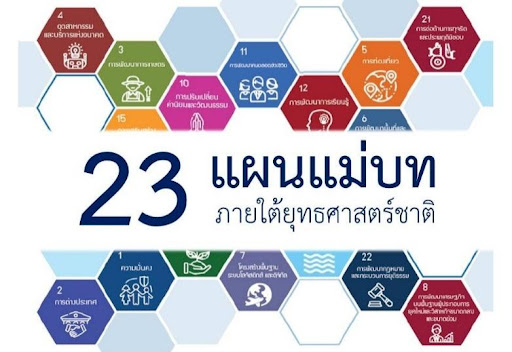
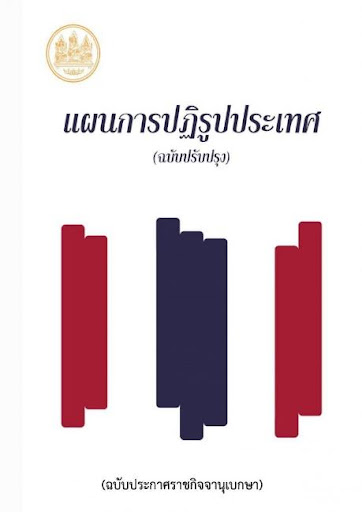
- The 13th National Economic and Social Development Plan B.E.2566-2570 (2023-2027) has a milestone that Thailand has a modern government with efficiency and respond to the public’s needs. One of the goals of this milestone include enhanced public service with quality and accessibility, and become a high capacity and agile government. The strategies consist of improve the quality of public service, changing and restructuring public administration, shift to digital government, enhance administrative system that increase personnel capacity, improve laws, regulations and measures to be more suitable for the country’s development.

- The current National Forest Policy B.E. 2562 (2019) emphasizes governance in one of the objectives which said to ensure effective forest resource governance system with a basis on knowledge, innovation, and participation of all sector. In the 24 policy provisions, there are 7 provisions on development of administration system and forestry organizations highlighting improving the organizational structures towards effective operations, using technology for fast and transparent public services, promote good governance, professionalism and better well fare to staffs at all levels, increase research and innovation development, and improve laws and regulations to be appropriate for the changes of the national and local contexts. In addition, the policy provisions under forest management emphasize the importance to cooperate and develop mechanisms and tools to support partnership and integration with all relevant sectors, ensure forest land classification and appropriate management and utilization, improve boundary of all types of forest land, manage the disputes concerning forest land tenure and use (https://forestinfo.forest.go.th/Content/file/policy/national_forest_policy.pdf).

- Thailand enacted a law, Official Information Act B.E.2540 (1997) to mandate state agencies to publish important official information in the Government Gazette and make available official information for public inspection and able to be requested. These information include structure and organization or its operation, summary of powers, duties, and operational methods, policy and relevant interpretations, workplans, annual expenditures, concessions or agreements with private sector, manuals or orders, etc. Another supporting law, Prevention and Elimination of Corruption Act B.E.2561 (2018) was amended from the previous act to strengthen the roles of National Anti-Corruption Commission.


- Following the national reform and national strategy the Thai government has passed several amended and new forestry laws to reflect the current situations, increase participation, and resolve on-going issues related to forest land tenure in the country. The key amended laws include Forest Act (No.8) B.E.2562 (2019), National Park Act B.E.2562 (2019), Wildlife Preservation and Protection Act B.E.2562 (2019). The new forestry laws include Marine and Coastal Resources Management Promotion Act B.E.2558 (2015), Elephant Ivory Act B.E.2558 (2015), Community Forest Act B.E.2562 (2019), National Land Policy Committee Act B.E.2562 (2019).




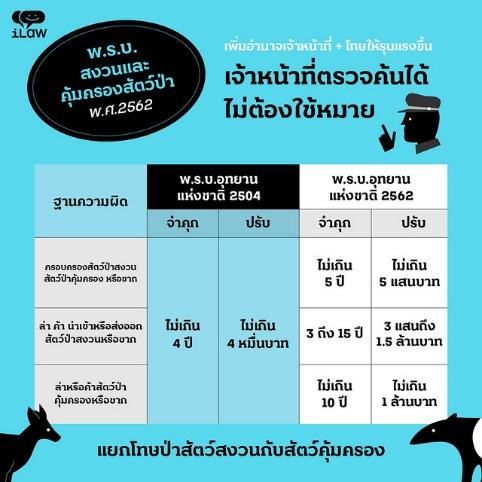

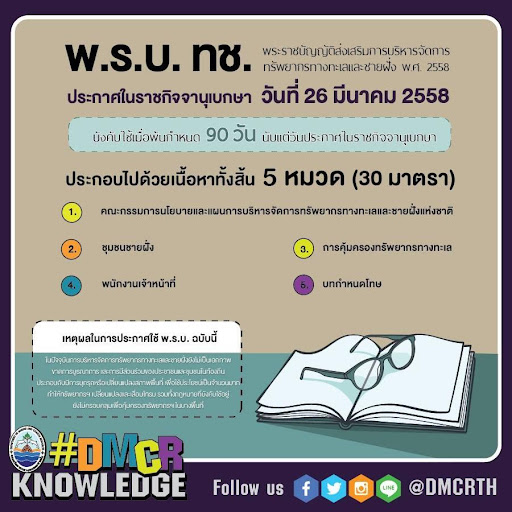
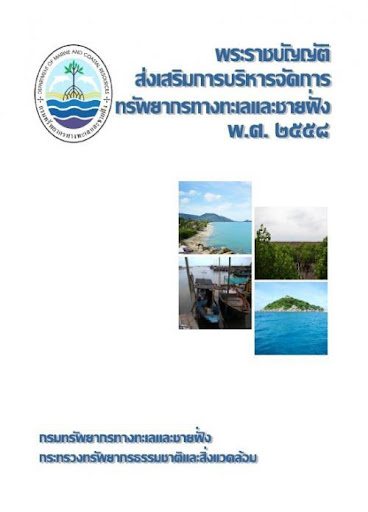


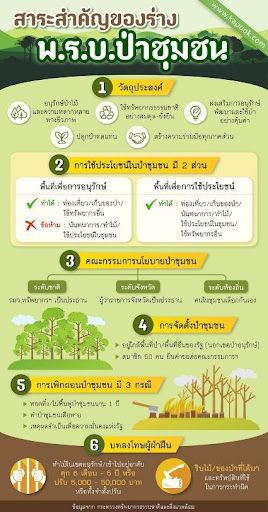
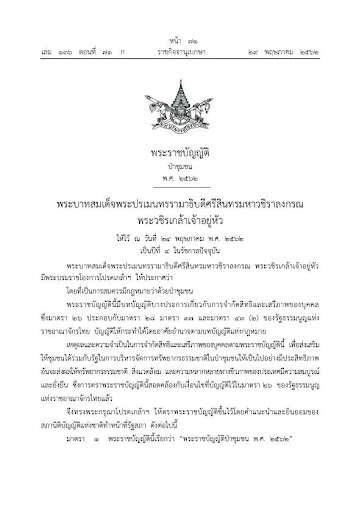
- Anti-corruption policy is embedded in the operation of all government agencies. All government at ministry and department levels are obliged to develop anti-corruption plan and procedure, and conduct annual Integrity and Transparency Assessment (ITA) and publish reports on their websites (links of key agencies - MoNRE http://www.mnre.go.th/anticor/th/index, DNP https://portal.dnp.go.th/p/DnpEthics, RFD https://www.forest.go.th/ethics/, DMCR https://dmcrth.dmcr.go.th/epg). Furthermore, all ministries and departments have developed a complaint and grievance mechanism, the links of key agencies are – MoNRE http://petition.mnre.go.th/MNRE_PETITION_59/index.php, DNP http://it2.dnp.go.th/th/ita/, RFD https://www.forest.go.th/e-petition/, DMCR https://www.dmcr.go.th/contact/inform .
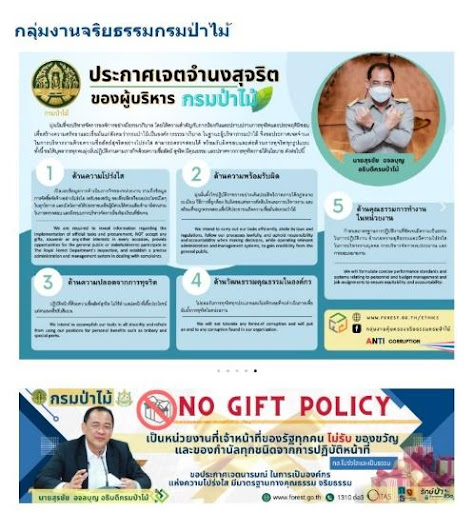
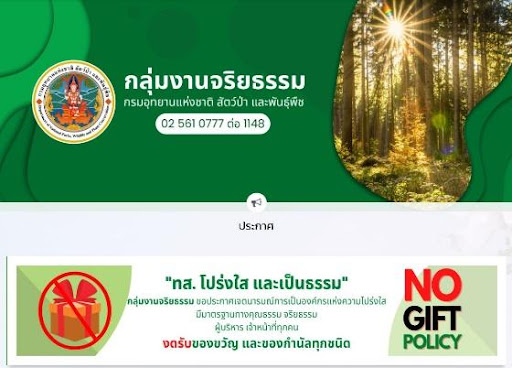
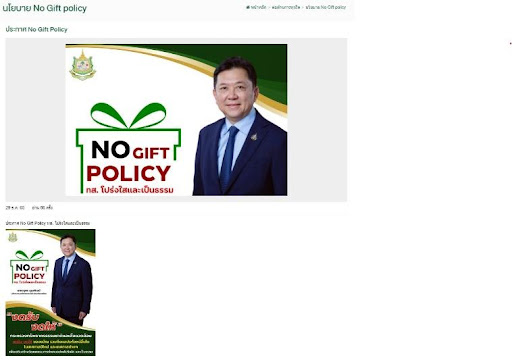

- On current REDD+ institutional structure, Department of National Parks, Wildlife and Plant Conservation (DNP) has been assigned to be the main coordinating unit of the country for REDD+ activities. However, the REDD+ framework requires cooperation from many sectors since drivers of deforestation and forest degradation are mainly occurred from outside the forest sector. The government established National REDD+ Task Force in 2011 that involved government agencies from different ministries, and non-government organizations include civil society, forest-dependent organizations, as well as academic and international organizations. The representatives from non-governmental party were nominated by their respective institution through a self-selection process. The current National REDD+ Task Force is chaired by the Permanent Secretary of the Ministry of Natural Resources and Environment (MoNRE) (a link to updated structure, roles and responsibilities, and list of organizations involved can be accessed at>>). At the implementation level, REDD+ Office is under supervision of DNP and have been implementing pilot activities through 9 regional learning centers under areas supervised by the department.
- REDD+ institutional structure proposed in the Draft National REDD+ Strategy, developed in 2021, highly recognized multi-sectors cooperation and integration and also considered for more efficient and continuation of REDD+ activities. A National REDD+ Steering Committee was proposed as a key policy body, to be chaired by the Permanent Secretary of the Ministry of Natural Resources and Environment (MoNRE). The committee comprised of government agencies from different ministries, and including representatives of the private sector, civil society and academic institution. It was proposed that several Technical Working Groups to be appointed include: TWG on Measurement, Report and Verification, TWG on Environmental and Social Impact Assessment, TWG on Funding and Benefit Sharing, and TWG on Capacity Building and Participation; consist of experts in each field from government and including representatives of the private sectors, civil society, and academic. Thailand REDD+ Office is proposed to be under supervision of MoNRE, chaired by Deputy Permanent Secretary of MoNRE with key functions include planning and administration unit, REDD+ Fund Management Unit, Regional/Provincial REDD+ Centers which will have Director of the Provincial Office of Natural Resources and Environment as the head of the center.
- Currently policy and supervision for REDD+ in Thailand is under the REDD+ Task Force which established as an inter-minitrial and multi-sectoral committee under the Sub-committee on Climate Change Policy and Planning Integration of the National Committee on Climate Change Policy. The RTF is chaired by the Director General of DNP as DNP is a national focal point for REDD+, DNP and ONEP coordinate closely and act in coordination both at national and international levels. Members of the RTF consists of representatives from key agencies related to the drivers of deforestation and forest degradation such as on land use, provincial and local administration, forest industry, human rights and indigenous people’s rights, etc.
- Further information on how safeguard B is respected will be complied and monitored using the following indicators.
2.1.1 Government agencies that are involved in the administrative structure for REDD+ and/or other programs come from a variety of sectors covering forest management, environment, land use, and sustainable development of communities’ quality of life.
2.1.2 Proportion of the representatives from civil society organizations, private business sector, and local communities in administrative structure and the process/criteria to recruit the representatives from these sectors are derived by the agreement of stakeholders.
2.1.3 List of MoUs developed between MoNRE and forest departments with other sectors to ensure effective cross-sectoral coordination and integration to implement the REDD+ and other policies and plans (special attention to sectors that are related to drivers of deforestation and forest degradation)
2.1.4 Number of programs/projects that use and strengthen existing multi-stakeholders’ platform for the project administration and implementation (e.g. Protected Area Advisory Committee, Watershed Committee, Provincial CFM Committee, etc.)
2.2.1 The clear responsibilities, work plans and budget plans of the institutions to manage REDD+ and other forest-based climate mitigation programs at national and sub-national levels are available and/or can be requested by stakeholders.
2.2.3 Websites are developed to disseminate updated information related to national strategies, plans, and progress of implementation using appropriate languages, and the information in the website is regularly updated.
2.2.4 Finance to support implementations at both national and sub-national levels are summarized and can be requested by stakeholders.
2.3.2 Medias and communication materials are produced and disseminated regularly using appropriate channels and languages to enhance understanding of relevant stakeholders, especially local and ethnic communities, and vulnerable groups (women, youth, the elderly, the disabled).
2.3.3 Information is available on grievances and received and resolved, with summary of average time to resolve, summary of the procedures to resolve grievances and complains; classified by forest management types (national reserved forests, national parks, etc.), by the type of activities or measured defined in the strategy/action pan, and by those affected (e.g., by gender and stakeholder groups).
2.1.1 Government agencies that are involved in the administrative structure come from a variety of sectors covering forest management, environment, land use, and sustainable development of community’s quality of life.
2.1.2 Proportion and process/criteria to recruit the representatives from civil society organizations, private business sector, and local communities in administrative structure are derived by the agreement of stakeholders.
2.1.3 List of MoU developed between MoNRE and forest departments with other sectors to ensure effective cross-sectoral coordination and integration to implement the policies and plans (special attention to sectors that are related to drivers of deforestation and forest degradation).
2.1.4 Number of programs/projects that use and strengthen existing multi-stakeholders’ platform for the project administration and implementation (e.g. Protected Area Advisory Committee, Watershed Committee, Provincial CFM Committee, etc.)
2.2.1 The clear responsibilities, work plans and budget plans of the institutions to manage REDD+ and other forest-based climate mitigation programs at national and sub-national levels are available and can be requested by stakeholders.
2.2.2 The national strategies and action plans must clearly identify communication and stakeholders’ capacity building strategies/measures to ensure effective participation and access to information, especially local communities, ethnic groups and vulnerable groups.
2.2.3 Central websites are developed to disseminate updated information related to national strategies, plans, and progress of the implementations using appropriate languages, and the information in the website is regularly updated.
2.2.4 Finances to support implementations at both national and sub-national levels are summarized and can be requested by stakeholders.
2.2.5 Number of projects that use and strengthen existing multi-stakeholders’ platform for the project administration and implementation (e.g. Protected Area Advisory Committee, Watershed Committee, Provincial CFM Committee, etc.).
2.3.1 Preparation of national strategies and action plans of REDD+ and other forest-based climate mitigation programs are developed with the participation of all relevant stakeholder groups, including local and ethnic communities, and with gender inclusion.
2.3.2 Medias and communication materials are produced and disseminated regularly using appropriate channels and languages to enhance understanding of relevant stakeholders, especially local and ethnic communities, and vulnerable groups (women, youth, the elderly, the disabled).
2.3.3 Grievances and feedbacks procedures developed and are in place to address complaints.
2.3.4 Information is available on grievances received and resolved, with summary of average time to resolve, summary of the procedures to resolve grievances and complaints; classified by forest management types (national reserved forests, national parks, etc.), by the type of activities defined in the strategy, and by those affected (e.g., by gender and stakeholder groups).
2.1.1 Government agencies that are involved in the administrative structure come from a variety of sectors covering forest management, environment, land use, and sustainable development of community’s quality of life.
2.1.2 Proportion and process/criteria to recruit the representatives from civil society organizations, private business sector, and local communities in administrative structure are derived by the agreement of stakeholders.
2.1.3 List of MoU developed between MoNRE and forest departments with other sectors to ensure effective cross-sectoral coordination and integration to implement the policies and plans (special attention to sectors that are related to drivers of deforestation and forest degradation).
2.1.4 Number of programs/projects that use and strengthen existing multi-stakeholders’ platform for the project administration and implementation (e.g. Protected Area Advisory Committee, Watershed Committee, Provincial CFM Committee, etc.)
2.2.1 The clear responsibilities, work plans and budget plans of the institutions to manage REDD+ and other forest-based climate mitigation programs at national and sub-national levels are available and can be requested by stakeholders.
2.2.2 The national strategies and action plans must clearly identify communication and stakeholders’ capacity building strategies/measures to ensure effective participation and access to information, especially local communities, ethnic groups and vulnerable groups.
2.2.3 Central websites are developed to disseminate updated information related to national strategies, plans, and progress of the implementations using appropriate languages, and the information in the website is regularly updated.
2.2.4 Finances to support implementations at both national and sub-national levels are summarized and can be requested by stakeholders.
2.2.5 Number of projects that use and strengthen existing multi-stakeholders’ platform for the project administration and implementation (e.g. Protected Area Advisory Committee, Watershed Committee, Provincial CFM Committee, etc.).
2.3.1 Preparation of national strategies and action plans of REDD+ and other forest-based climate mitigation programs are developed with the participation of all relevant stakeholder groups, including local and ethnic communities, and with gender inclusion.
2.3.2 Medias and communication materials are produced and disseminated regularly using appropriate channels and languages to enhance understanding of relevant stakeholders, especially local and ethnic communities, and vulnerable groups (women, youth, the elderly, the disabled).
2.3.3 Grievances and feedbacks procedures developed and are in place to address complaints.
2.3.4 Information is available on grievances received and resolved, with summary of average time to resolve, summary of the procedures to resolve grievances and complaints; classified by forest management types (national reserved forests, national parks, etc.), by the type of activities defined in the strategy, and by those affected (e.g., by gender and stakeholder groups).
